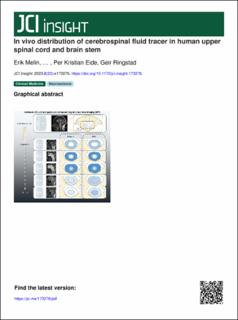In vivo distribution of cerebrospinal fluid tracer in human upper spinal cord and brain stem
Peer reviewed, Journal article
Published version
Permanent lenke
https://hdl.handle.net/11250/3116763Utgivelsesdato
2023Metadata
Vis full innførselSamlinger
Originalversjon
10.1172/jci.insight.173276Sammendrag
BACKGROUND. Intrathecal injection is an attractive route through which drugs can be administered and directed to the spinal cord, restricted by the blood-spinal cord barrier. However, in vivo data on the distribution of cerebrospinal fluid (CSF) substances in the human spinal cord are lacking. We conducted this study to assess the enrichment of a CSF tracer in the upper cervical spinal cord and the brain stem.
METHODS. After lumbar intrathecal injection of a magnetic resonance imaging (MRI) contrast agent, gadobutrol, repeated blood samples and MRI of the upper cervical spinal cord, brain stem, and adjacent subarachnoid spaces (SAS) were obtained through 48 hours. The MRI scans were then analyzed for tracer distribution in the different regions and correlated to age, disease, and amounts of tracer in the blood to determine CSF-to-blood clearance.
RESULTS. The study included 26 reference individuals and 35 patients with the dementia subtype idiopathic normal pressure hydrocephalus (iNPH). The tracer enriched all analyzed regions. Moreover, tracer enrichment in parenchyma was associated with tracer enrichment in the adjacent SAS and with CSF-to-blood clearance. Clearance from the CSF was delayed in patients with iNPH compared with younger reference patients.
CONCLUSION. A CSF tracer substance administered to the lumbar thecal sac can access the parenchyma of the upper cervical spinal cord and brain stem. Since CSF-to-blood clearance is highly individual and is associated with tracer level in CSF, clearance assessment may be used to tailor intrathecal treatment regimes.

